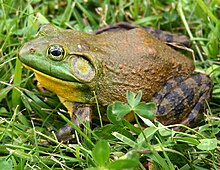
Back Rana catesbeiana AN ضفدع الثور Arabic ضفدع الثور ARZ Жаба-бык Byelorussian Жаба бик Bulgarian Ran-darv Amerika Breton Granota toro Catalan Lithobates catesbeianus CEB Skokan volský Czech Шапа-вăкăр CV
| American bullfrog | |
|---|---|

| |
| adult male | |
| Scientific classification | |
| Kingdom: | |
| Phylum: | |
| Class: | |
| Order: | |
| Family: | |
| Genus: | |
| Binomial name | |
| Rana catesbeiana (Shaw, 1802)
| |

| |
| Native range Range as an invasive species | |
The American bullfrog (Rana catesbeiana or Lithobates catesbeianus) is a semi-aquatic frog. It belongs to the family Ranidae, or 'true frogs'. Bullfrogs are native to most of North America, Canada and Mexico. The ones that live in northern America hibernate during winter. However, bullfrogs in southern US states are active all the time. Bullfrogs have been seen in South America, Asia, Western Europe and the Caribbean. These bullfrogs were brought on ships. Many people, including pet owners, have placed bullfrogs outside of their native area. They have done this: on purpose because they no longer want them, to control the pest population, or by accident by catching them in fishing nets.
Bullfrogs can adapt and live almost anywhere if there is water nearby. They can eat rodents, insects, small fish, arachnids, small birds, crustaceas, small mammals, worms, and other frogs. Because of this, they have been blamed for many animal extinctions. Bullfrogs live in large bodies of water such as swamps, lakes, and ponds. They like to stay near the edge of the water. During a rainstorm, they may travel on land. They travel in search of a new habitat.
Bullfrogs are prey to various birds like herons, and their life in the wild is much less than in captivity. One captive bullfrog lived almost 16 years. The name "bullfrog" was given because males roar when mating with a female. Bullfrogs can be kept as pets. Captive bullfrogs are given rodents, small fish, crickets, worms, and fruit flies as food and treats. Pet owners may add supplements on the frogs food for health. Bullfrogs can host many viruses, bacteria and parasites. They were blamed for an intraerythrocytic virus outbreak in Canada in 1997. Bullfrogs are the cause of the chytrid fungus spreading into Arizona. The fungus is one of the main reasons that there are fewer amphibians.
A female bullfrog can lay up to 20,000 eggs. Bullfrog tadpoles take up to a year to become a young frog. Males will stay behind and take care of the tadpoles. Males are territorial and will attack any animal, including their own kind, if they come near them. Bullfrogs can reduce the mosquito population. They do this by eating most of the mosquito's larvae. Bullfrogs do not move during the day, except if there is food nearby or when threatened.
Bullfrog legs are eaten by humans. The International Union for the Conservation of Nature (IUCN) rates the bullfrog as "Least Concern", which means that they are not an endangered species. However, they are dying because of habitat loss, water pollution[broken anchor], pesticides, and over harvesting.
- ↑ "Lithobates catesbeianus". International Union for Conservation of Nature and Natural Resources. Archived from the original on 5 June 2011. Retrieved 18 June 2012.
© MMXXIII Rich X Search. We shall prevail. All rights reserved. Rich X Search
